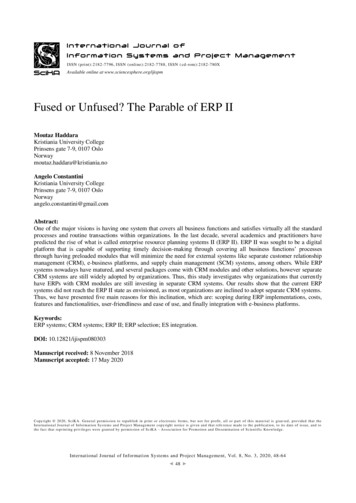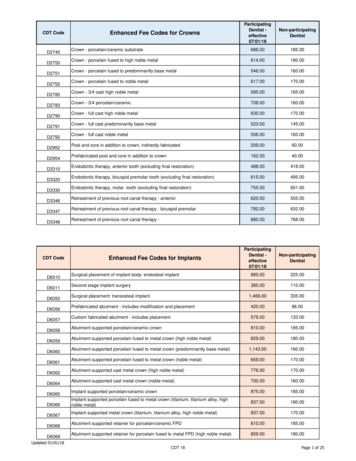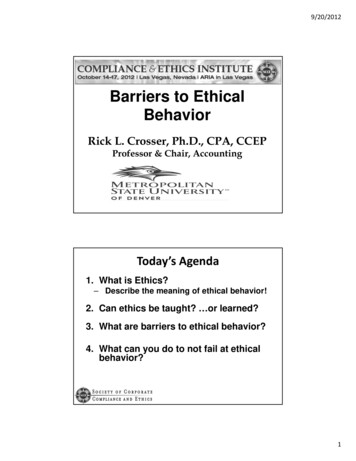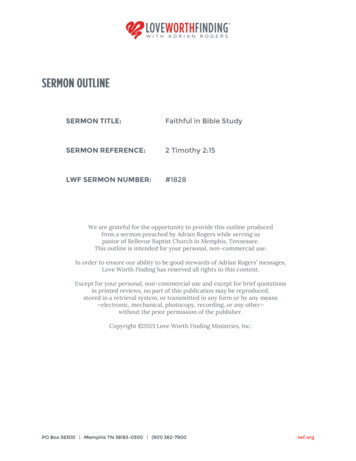
Transcription
ISSN (print):2182 -7796, ISSN (online):2182-7788, ISSN ( cd-rom): 2182-780XAvailable online at www.sciencesphere.org/ijispmFused or Unfused? The Parable of ERP IIMoutaz HaddaraKristiania University CollegePrinsens gate 7-9, 0107 OsloNorwaymoutaz.haddara@kristiania.noAngelo ConstantiniKristiania University CollegePrinsens gate 7-9, 0107 OsloNorwayangelo.constantini@gmail.comAbstract:One of the major visions is having one system that covers all business functions and satisfies virtually all the standardprocesses and routine transactions within organizations. In the last decade, several academics and practitioners havepredicted the rise of what is called enterprise resource planning systems II (ERP II). ERP II was sought to be a digitalplatform that is capable of supporting timely decision-making through covering all business functions’ processesthrough having preloaded modules that will minimize the need for external systems like separate customer relationshipmanagement (CRM), e-business platforms, and supply chain management (SCM) systems, among others. While ERPsystems nowadays have matured, and several packages come with CRM modules and other solutions, however separateCRM systems are still widely adopted by organizations. Thus, this study investigates why organizations that currentlyhave ERPs with CRM modules are still investing in separate CRM systems. Our results show that the current ERPsystems did not reach the ERP II state as envisioned, as most organizations are inclined to adopt separate CRM systems.Thus, we have presented five main reasons for this inclination, which are: scoping during ERP implementations, costs,features and functionalities, user-friendliness and ease of use, and finally integration with e-business platforms.Keywords:ERP systems; CRM systems; ERP II; ERP selection; ES integration.DOI: 10.12821/ijispm080303Manuscript received: 8 November 2018Manuscript accepted: 17 May 2020Copyright 2020 , Sc iK A. Genera l perm iss ion to republish in pr int or e lectronic f orm s, but not for profit , a ll or part of th is m ater ia l is gran ted, provided that theInternationa l Journal of Inform at ion System s and Project Managem ent copyright notice is given and that r efe rence m ade to the publicat ion, to its date of issue, and tothe fact that repr int ing pr ivile ges we re granted by perm iss ion of Sc iKA - Assoc iat io n for Prom otion and Dissem inat ion of Sc ient if ic Knowledge.International Journal of Information Systems and Project Management, Vol. 8, No. 3, 2020, 48-64 48
Fused or Unfu sed? The Parable of ERP II1.IntroductionEnterprise Resource Planning (ERP) systems evolved in order to address the islands of information challenge, or whatis known as stovepipe systems within organizations. Stovepipe systems are functional systems, which lack seamlessintegration between the different business functions in organizations. Thus, ERP systems were created to support andsolve the integration challenges among the various business functions through using one logical database with severalfunctional modules [1]. Because ERP systems are pre-designed to fit many different organizations, ERP systems comewith pre-loaded and embedded best practices and industry standard processes [2]. ERP vendors and their key customersoften jointly develop and define these best practices and processes. Hence, those best practices do not necessarilyrepresent how the majority of enterprises conduct their business [2]. Due to their size and complexity, ERP systems’implementations require a substantial amount of resources and careful project management procedures [3].Since 2000, several authors and practitioners have predicted that customer relationship management (CRM) modules,domain-specific operations, and e-business enablement will become standard solutions in future ERP packages [4].They called it ERP II, as an evolution and extension to the traditional ERP. Indeed, major ERP vendors have respondedto this vision and currently offer pre-customized domain-specific systems, e-business ready modules or interfaces, andCRM modules and applications. While most ERP systems have a CRM module included, such as the major closedsource and open source ERP packages, however in practice, we still observe that a large number of organizations is stilladopting stand-alone CRM systems. Thus, in this paper we attempt to explore the reasons why organizations are stillinvesting in separate CRM systems, which might not even be integrated to other core processes of the company, insteadof using the CRM module that comes with their ERP system. Hence, we have conducted a multiple case study in whichwe have interviewed informants from seven case organizations in Austria, Egypt, Norway, and the United Kingdom. Inaddition, in an attempt to capture a wider spectrum of different perspectives on the topic under-study, we have alsointerviewed various ERP stakeholders including implementation partners, consultants, and vendors. We would thereforelike to explore the main reasons and motivations that lead organizations that are using an ERP system already, foradopting a separate CRM system. The results from this research may aid ERP vendors in identifying the currentweaknesses of their systems (if any) and aid them in developing future full-fledged systems that can replace most of theorganisational digital infrastructure and scattered applications.This paper is organized as follows: the following section presents the study’s background literature. In section 3, weintroduce our target cases and research methodology. Research results and discussion are presented in section 4, andfinally our conclusions and recommendations for future research are provided in section 5.2.Literature BackgroundThis research focuses on the observed phenomenon of organizations investing in a separate CRM system even thoughseveral of these organizations might already have a CRM module in their acquired ERP system. The authors haveobserved this trend in several companies in practice. Below, we introduce the basic concepts and background literaturefor this study.2.1 ERP SystemsERP systems are the largest type of enterprise systems. Enterprise systems are enterprise-wide applications, which arevirtually used by the various business functions inside organizations. Other types of enterprise systems include CRMsystems, supply chain management (SCM) systems, and any other enterprise-wide scale system. ERP systems handlebasic corporate and business functions, such as finance, human resources, materials management, sales and distribution[5]. In the 1990s, ERP systems were proliferating among companies and turnovers of software vendors were high [6].ERP systems were initially targeting large enterprises, however due to market saturation, vendors started to createlighter versions that can fit small and medium-sized enterprises (SMEs) [7]. With the current trend of moving into the“cloud” and the accompanying change to subscription-based payment plans [8], the business model of many softwarevendors has changed. The most popular players in the market today are SAP, a German company with customers in 190International Journal of Information Systems and Project Management, Vol. 8, No. 3, 2020, 48-64 49
Fused or Unfu sed? The Parable of ERP IIcountries and an annual turnover of ca. 25 Billion Euros [9], and Oracle, a US-based company, which is also known fortheir database management systems among other products, has ca. 420 000 customers and a current annual turnover of37 Billion USD [10].In general, ERP implementation projects involve several stakeholders including the internal IT staff and key businessusers from inside the organization, as well as, external consultants, or consultants from the implementationpartners/vendors [1, 11]. It is recommended that adopting organizations should develop control mechanisms to ensurethat the external consultants work in favor of the project and its goals [12]. ERP system implementation projects maydiffer from traditional system implementations in scale, scope, complexity, organizational changes, project costs, andthe need for business process reengineering [13]. The percentage of ERP project failures is over 60% and half of all top10 failures of all time are from market leading ERP vendors [14]. A more recent survey conducted by PanoramaConsulting Solutions reports that 74% of the participating organizations in the survey have crossed their estimated ERPimplementation budgets for several reasons, but one of the main reasons was due to unexpected changes inorganizational or technical requirements [15]. In addition, 59% of the projects crossed their go-live schedules, mainlydue to project scoping issues [15]. Moreover, the survey results also show that 56% of the organizations have sufferedfrom production disruptions for varying time periods [15]. Software vendors have established so-called ‘best practices’.These are primarily processes, which are supposed to be the ideal and standard practices in particular industries.Software vendors dedicated a lot of effort in investigating and identifying these practices from organizations andacademic theories [16]. Many ERP packages are implemented using these best practices, meaning that theimplementing organization adopts all or parts of these best-practices. This implementation type is called “vanilla”.When implementations are made which mainly use the suggested processes, most organizations need to committhemselves to some form of business process reengineering [16]. While this usually involves costs and efforts, Robey etal. [5] state that the primary benefit from implementing an ERP system might result from adopting new businessprocesses.In general, ERP system implementations are complex and resource-intensive projects [17], spanning from the adoptiondecision, the acquisition phase, the actual implementation phase to the use and maintenance phase, the evolution phase,and eventually followed by the retirement phase [18], as depicted in the figure below.Fig. 1. The ERP lifecycle framework. Adapted from [18].2.2 ERP System SelectionThe selection of an ERP vendor and the respective product is a part of the acquisition phase in the ERP Lifecycleframework. Somers and Nelson [13] present several critical success factors (CSF) across the stages of an ERPimplementation: they identified that besides architecture choice, the most important success factors in the selectionphase are clear goals and objectives, partnership with vendor, top management support as well as a careful selection ofthe package. Especially the CSF “clear goals and objectives” and “careful selection of the package” seem at first glanceto be two potential answers to the research question of this study.During the selection phase, system and organization fitness is regarded as a crucial issue. Several information systemsimplementations fail due to the selection of a non-fitting system [1]. The fitting process happens between the ERPsystem and the organization needs, requirements, and expected future evolvement and scalability. The topic of “fit” hasbeen regarded as of paramount importance and has been frequently discussed in IS literature in general, and specificallyin enterprise resource planning domain [1]. A wrong ERP system selection would either totally fail the project, orcritically weaken the system and negatively affect the company’s performance [19], and also may lead to an early ERPInternational Journal of Information Systems and Project Management, Vol. 8, No. 3, 2020, 48-64 50
Fused or Unfu sed? The Parable of ERP IIretirement in some cases [20]. When deciding on the desired functionalities in the potential ERP, it is useful and, inmost cases also required, to separate the “nice to have” from the “need to have” functionalities [21], and to focus on thegoals and objectives that are to be achieved with the system. In practice, consultants regularly conduct an evaluation ofthe requirements, often however, requirements are only inferred and indirectly suggested by the ERP adoptingorganizations [1].In literature, several studies aimed at identifying factors that could potentially affect the ERP selection outcome inorganizations, and provided recommendations and criteria to optimize the selection process [1]. For instance, a studypresented several factors that may affect the selection criteria, which include the ERP-to-organization fitness as animportant factor [22]. During the selection phase, it therefore seems beneficial to scrutinize the current processes, beforematching the company’s requirements with the features and functionalities of the potential system [1]. In addition, Deepet al. [23] developed a framework for the ERP system and vendor selection processes. The framework presents thevarious stages and phases in the selection process, which starts with the requirements and project planning, identifyingpotential vendors, evaluation, and finally ends with the selection of the appropriate ERP package. The framework alsoillustrates several iterative tasks to be accomplished by the project team at each stage. Thus, the ERP selection processis a challenging task. This is mainly due to the scarcity of available resources within organizations, the complex natureof ERP packages, and the various ERP system alternatives in the market [24]. In addition, Esteves & Pastor (1999)argue that the price of the package, training and maintenance services provided by the vendor, return on investment(ROI) estimation, and the contractual agreement are defined during the selection process.In our theoretical background, we focus on the selection process of ERP systems. We do so, because we hypothesizethat the main grounds for acquiring a separate CRM either lie in the selection process of the ERP system (in otherwords: has the wrong ERP solution been chosen?) or this happened due to other reasons, such as the ERP system’scharacteristics or issues that cannot be influenced directly (e.g. internal political decisions).2.3 CRM SystemsCustomer relationship management as such, is a comprehensive strategy, and includes the processes of acquiring,retaining, and cooperating with segmented customers in order to maximize the value for the organization and itscustomers [25]. This includes the full integration of marketing, sales, and customer service functions and processes inorder to maximize efficiency and effectiveness in delivering customer value [25]. These processes can be supportedtechnologically by CRM systems, which manage all the channels, interactions, and touch and contact points betweenthe organization and the customers.CRM literature points out the importance of a single-view of the customer across all contact channels [26]. In addition,CRM systems have been widely adopted and aided in helping organizations to reach and contact customers, and togenerate comprehensive analyses of their customers by collecting, storing and analysing customer data [27].CRM systems are typically considered a type of Enterprise Systems. Even though existing literature differentiatesbetween the scope of ERP systems that mainly capture operational (internal) data, and CRM systems’ scope of focusingand capturing customer (external) data [28], however most ERP systems nowadays include a customer relationshipmanagement module or related applications.With many CRM solutions establishing themselves in the market, such as Microsoft Dynamics, Salesforce, SugarCRM,HubSpot and other providers, the CRM market has been estimated to a total of 12 Billion USD in 2019 [29]. Accordingto Forbes [30], Salesforce is the current market leader and holds a market share of more than 19% of global share.Salesforce is a cloud-only provider, which, besides sales modules, offers modules for marketing, service desks,analytics, community (social networks) and e-commerce. In Reinartz et al. [26], they state that the use of CRM systemsis projected to advance the ability of an organization to endure profitable customer relationships by enablinginformation to be integrated and shared smoothly. Customer relationship is assumed to be a people-driven process [26],meaning that building and enforcing customer relationships have to come from the organization and the people thereinand software can only support this process. Prior research in this area found that by implementing a CRM systemInternational Journal of Information Systems and Project Management, Vol. 8, No. 3, 2020, 48-64 51
Fused or Unfu sed? The Parable of ERP IIwithout established processes and people in place, the actual customer relationship performance may drasticallydeteriorate [26].2.4 ERP IIThe ERP II vision refers to an extended version or the next generation of ERP systems [31]. In 2000, Gartner groupdefined ERP II as a business strategy and a set of industry-domain-specific applications, which optimize enterprise andinter-enterprise, collaborative-operational and financial processes, in order to build and maximize customer andshareholder value [32]. Thus, ERP II was envisaged to virtually provide all the related integrations among front- andback-office systems (ERP I), plus all system functionalities that are included within CRM, supply chain management(SCM) systems [4, 31], and provide business intelligence (BI) capabilities [33]. Most of these processes and functionswould mainly be available through modular on-demand add-ons to the system, like CRM-related solutions, datawarehousing applications, and web portals [33, 34].Besides sales force automation (SFA) and cost (SFC) management, ERP II was also foreseen to integrate all ecommerce related processes with the corporate supply chain [33]. Figure 2 presents an overview of the organizationalareas and processes that ERP II is intended to cover. The areas are CRM, PLM (product lifecycle management), SRM(supplier relationship management), HRM (human resource management), CPM (corporate performance management),and SCM. In addition, ERP II was envisioned to provide back and front-end applications to enable business-tocustomer, business-to-business and business-to-employee operations. Moreover, ERP II should facilitate the enterpriseapplication integration (EAI) with other systems [4]. Thus, due to their massive scale and coverage of the micro andmacro environments’ stakeholders, and the different business functions and operations, ERP II systems were and areexpected to be very complex to implement [31, 34, 35].Fig. 2. ERP II Umbrella. Adapted from [33].ERP II implementation projects should not be only regarded as IT projects, they rather should be considered as businessprojects. This is mainly due to the considerable time of business engagement of the various key employees from thevarious business functions within organizations in contrast to their IT departments’ peers [34]. In the year 2005, Møllerargued that Gartner’s vision of the next generation ERP (ERP II) has been matched by ERP’s vendors as major ERPInternational Journal of Information Systems and Project Management, Vol. 8, No. 3, 2020, 48-64 52
Fused or Unfu sed? The Parable of ERP IIsystems currently (in 2005) have several interfaces, modules, and add-ons to meet that vision [33]. Looking now, wecan see that most ERP systems facilitate EAI within organizations (e.g. SOA), and their SCM related modules havesatisfied the need for adopting separate SCM systems for many organizations, however, we argue that this is not yet thecase when it comes to CRM systems. In general, the ERP literature lacks sufficient research on exploring the status of“ERP II” initiatives in the industry [33]. Based on the authors’ experiences in the industry, it is hypothesized thatorganisations still prefer to have stand-alone CRM systems along with their ERP systems, instead of having all-in-onesolutions. Thus, in this paper we attempt to test this hypothesis and explore the reasons why organizations are stillinvesting in separate CRM systems, which might not even be integrated to other core processes of the company, insteadof using the CRM module that comes with their ERP system.3.Research MethodologyThis research followed an explorative research methodology, which can potentially aid in providing a betterunderstanding of the phenomenon or problem understudy [36]. In general, exploratory research is a satisfactory methodfor investigating and explaining why certain phenomena occur [37]. Exploratory research is usually undertaken forthree main purposes, namely analysing a situation, assessment of alternatives and discovering new ideas andphenomena [38]. One of the foundations of this genre of research is the use of a hypothesis, in which the researcherstest the viability of certain hypotheses or research questions [39]. Thus, the authors hypothesized and questioned theviability of ERP II in practice. Specifically, the authors conducted a multiple case study [37] with ten semi-structuredqualitative interviews [36] in organizations, plus six additional interviews with other stakeholders. According to Yin[37], a case study research method is recommended when “how” and “why” questions are probed, when the researcherhas diminutive control on the events, and when the focus of the investigator is on a current phenomenon that occurs in areal-life context. According to Thomas [40], case studies can include the analyses of events, persons, decisions, periods,projects, institutions, or any other systems that are scrutinised and studied holistically through one or more researchmethods.The data collection process was conducted between February 2017 to June 2018. The interviews were carried out invarious organizations working in different industries, and within various geographical regions. The industries included:banking, business consulting, construction building information management (BIM), retail, manufacturing, andtelecommunications. Other interviews have also been conducted with ERP consultants, implementation partners andvendors. The participants included a mixture of stakeholders who have been involved in ERP and CRM systemsimplementations. Altogether sixteen interviews gathered information from these different stakeholders. The informantshad experience in various local, international, and open source ERP and CRM systems. More details regarding thesampling and data collection process are presented in section 3.2.In the following table, the informants’ details from the eight target cases and other interviewees are introduced in moredetails. The company names are fictitious to preserve anonymity.Table 1. Overview of cases and zation 1BankingLargeNorwayCustomer service employeeOrganization 2ConsultingSmallUnited KingdomMarketing managerOrganization 3ConsultingSmallAustriaOrganization 4Construction-BIMLargeNorwayIT Application consultantOrganization 5Clothing ManufacturerSmallNorwaySales managerOrganization 6Retail & Food ManufacturingLargeEgyptSenior ERP ConsultantMarketing employeeHead of salesInternational Journal of Information Systems and Project Management, Vol. 8, No. 3, 2020, 48-64 53
Fused or Unfu sed? The Parable of ERP ntSales employeeOrganization 7Marketing employeeOrganization 8BankingLargeNorwaySenior business support employeeImp. partner 1Implementation PartnerLargeCzech RepublicSenior SAP ConsultantImp. partner 2Implementation PartnerSmallEgyptJunior implementation consultantERP VendorMediumEgyptGeneral managerVERP senior consultantCons 1Not applicableNot applicableNorwayIndependent ERP consultantCons 2Not applicableNot applicableSwedenIndependent ERP consultant3.1 Interview guide and casesThe interview guide was developed by the authors in order to gather insights about the topic understudy. The authorsused constructs from the existing body of knowledge on CRM, ERP, and ERP II, plus their practical experience as basisfor the questionnaire development. The questionnaire covered several topics, including reasons and motivations forCRM adoptions, capabilities of the CRM vs. ERP s CRM modules, challenges with current ERP and the CRM-relatedactivities, CRM and ERP integration plans, and implementation costs. Moreover, we also asked about the status of ERPII from the points of view of our informants. In a column to the right of the questions, potential follow-up questionswere listed. A sample of the pool of questions is presented below: What were the organization’s motivations for investing in an ERP system?What were the organization’s motivations for investing in a separate CRM system?Did you consider acquiring a single ERP II system instead of investing in multiple systems? Why/why not?In your opinion, what are the main challenges for implementing an ERP II solution?Is your ERP system integrated with the CRM system?Do you have other standalone systems (e.g. e-commerce platforms)?Are you planning on replacing your existing systems with ERP II solution in the near future? Why/why not?Because of the adoption of an interview guide, there existed some systematic controls during the interviews [41]. Theinterview guide was sent to other peers in order to get feedback on the questions and clarity of the guide. Someimportant feedback was received about the vagueness of some questions, which were then enhanced. Later, theinterview guide was again revised and enhanced after the first two interviews. The revision contained some rewordingto some questions and also a change in the order of some questions, as the researchers learned what was more natural toask consecutively during the interviews. More information about the target organizations is provided below.Organization 1 is an international bank’s branch located in Norway. The bank is a large bank with more than 20,000employees worldwide. The bank operates in several countries around the world. Organization 1 offers offline and onlinebanking services to its customers. The bank has a B2B platform available for its business customers. In addition to SAPERP, the branch has a separate on-premise CRM system, and is currently in the process of evaluating other cloud-basedCRM systems.Organization 2 is a small consulting firm in the United Kingdom. The organization has ca. 30 employees and operatesin several countries around Europe. The organization has various systems including ERP, CRM, plus a specialized leadgeneration software. The organization operates in the area of business consulting focusing on aiding start-ups inestablishing their businesses. The company implemented an Oracle ERP in 2015. Besides the ERP, the organizationrecently implemented a CRM system. In addition, the organization uses a specialized application that aids the salesInternational Journal of Information Systems and Project Management, Vol. 8, No. 3, 2020, 48-64 54
Fused or Unfu sed? The Parable of ERP IIteam to easily find information on the Internet for lead-generation purposes. This application is separate from the CRMsystem.Organization 3 is a consulting company, located in Austria, which supports IT companies in the EMEA region byincreasing their revenue in their indirect sales channels. Their main clients are market leaders in their industry. Thecompany has approximately 35 employees, plus a network of approximately 20 independent partners (freelancers). Itwas founded in 2007 and implemented its first ERP System, SAP BusinessOne, in 2009. The system experienced amajor upgrade to the latest available version then, in 2014. The decision to implement a CRM system was taken in2015, after the company had used SharePoint and Excel Sheets to administrate their leads. The organization decided touse HubSpot CRM, a system provided by the US-based company HubSpot, which besides sales also offers solutions formarketing activities. The CRM system is free of charge, but has chargeable add-ons, especially in the area of advancedreporting and marketing. At the time of writing this paper, no add-ons have been acquired by the case organization.Organization 4 is a large Norwegian company working in the area of building information management (BIM) forconstruction companies. The interviewee is an IT applications consultant and has around 20 years of experience in salesand 10 years of experience with digital business systems in the role of a product owner. The current position isdescribed to be the bridge between the product owners of their many systems and the developers. The interviewee hasin-depth experience with CRM systems since almost 20 years. The organization has a Visma ERP system, and Superoffice CRM system. Both are local Norwegian systems.Organization 5 is a Norwegian company within the industry of manufacturing functional clothing. Originally foundedas a start-up in Oslo few years ago, the company now has retailers in all Scandinavia, UK, US, Netherlands, Germany,Austria and Switzerland. We have conducted an interview with the Sales Manager, which was involved during the ERPand CRM implementations that the company had earlier. Currently, the organization has a Norwegian financial system(Tripletex) that has a CRM module.Organization 6 is a retailer that deals with a various number of products, which are sold directly to customers throughtwo outlets. The company has been established in 2005 in Cairo and is now one of the largest supermarket chains inEgypt. The organization is considered a large enterprise, and its current workforce consists of more than 2,500employees. The retailing commodities vary from fresh food, fast moving goods, non-food commodities, textiles, andfurniture. The company production mainly focuses on food manufacturing and packaging. Prior to the current ERPadoption, they had a previous Oracle JD Edwards ERP and the implemented modules were FC, Capital AssetManagement, Manufacturing, Logistics, Procurement, and Sales & Distribution. The ERP went live in August 2007,and another upgrade was
They called it ERP II, as an evolution and extension to the traditional ERP. Indeed, major ERP vendors have responded to this vision and currently offer pre-customized domain-specific systems, e-business ready modules or interfaces, and CRM modules and applications. While most ERP systems have a CRM module included, such as the major closed










